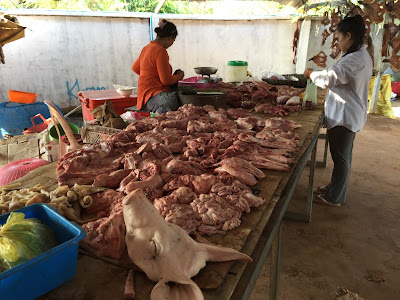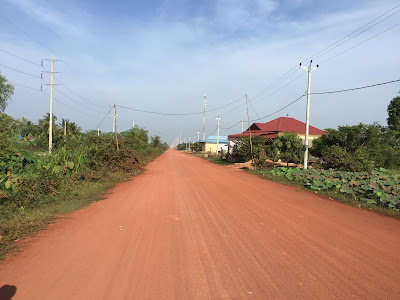On our second day in Siem Reap we went to tour the village of Krabei Real and have lunch in the home of a family there. The village is located about 15 minutes outside of Siem Reap. We started the morning at the village market, which was very small and consisted of a handful of stalls where everybody from the village brought their produce to sell to the rest of the village. Here we were met by our host and his 14-year-old daughter (who was bravely working on improving her English).



After buying the meat and veg, we walked down dirt roads, dirt paths, and finally a paved road, to the house of our hosts where we would be eating lunch. Now I enjoyed this walk - we learned a lot about village life while on it, but MAN was it hot and humid!


We saw lots of water buffalo - they hang out in the water to stay cool. Smart.


We saw several people, and in the pictures below a mother and her sons, fishing to catch food to eat that day. This is how many people in this village obtain their food.

We stopped by the home of some people who were rattan weavers (sorry no picture of the weaving) where we bought a few of their products for about $1 each (yes they use USD in Cambodia - a nice surprise for me). Okay I didn't get a picture of the women weaving but I got a picture of their pigs. They were really cute. I try not to think about the fact that they're raised to be eaten.

The weaver family also made rice wine. Most Cambodians are rice farmers and so, naturally, some of them find something interesting to do with the rice. This is also why they have pigs - making rice wine creates a lot of waste that's good feed for pigs. This was the rice wine making setup in their backyard.

And then we still had about another 30 minutes of walking. I almost died. The pic below is our guide, our host's 14-year-old daughter, and myself, walking through the warmest, sunniest, stillest area on earth. ;) Even the daughter said it was really hot! Note the usual method for this tour is via ox cart and not by foot, however I don't like riding in ox carts while the oxen are constantly whipped, so we opted to walk. Also, riding in ox carts is very bumpy, rough, and painful.

Lots of cows too. There are no milk cows in Cambodia - all milk is imported. Cows here are used for meat or for pulling carts.

Finally, we arrived at the home of our hosts. Here we learned many interesting things about Cambodian culture and life. For starters, there were 4 generations living in this home. When Cambodians get married, they move into the home of the *woman's* family. So the four generations in the house were based on the women - a grandmother, her daughter with her husband, their 2 daughters, and one granddaughter. They get married when they're around 18 - arranged marriages - so it's easy for so many generations to be around at once.
The women stay home and do all the cooking and cleaning here - so in the pictures below you can see the eldest daughter doing all the cooking. She made us a pork dish, a chicken dish, and a soup. And tons of rice - Cambodians eat rice three meals a day, and sometimes it's just plain white rice as they often don't have money to have anything in addition to it besides maybe some fruit.



Cambodians also eat on the floor, family style. It was kind of nice, though people who aren't very flexible will have a tough time sitting cross-legged for a meal. Below are pictures of the lunch spread. In the third picture below, the man on the left was our driver (we really loved him) and the guy on the right was one of our hosts.



Dessert was fresh fruit - watermelon, bananas, and the weird fruit below. I don't remember the name of it but it was pretty good!

After lunch we chatted a bit and we learned that the mother was the grandmother's only child because the grandfather was killed during the Pol Pot regime's genocide. This led to a lot of storytelling from each person of their personal experience during the genocide. As our guidebook said, you won't find a single person in Cambodia who was not affected by the genocide. Everybody lost at least one relative, has stories of walking by dead bodies, hiding in fields, etc, and they all share them very openly so that the world won't forget. I will write a separate blog about the genocide.
Below is a picture of our host's house. All houses in Cambodia are built on stilts, or are built at least so that there is nothing on the bottom floor and it is open-air in case of flooding. They all have a staircase going directly into the second floor of the house. Not all areas of Cambodia flood, but everybody seems to build their houses this way, "just in case". I think our host's house is the most closed-off house I saw in Cambodia, however the bottom floor was completely empty so it still had the idea of having an empty bottom floor.

Here is a video I took during our drive out of Siem Reap the following day - you can see (sorry it's kind of fast) how all the houses are on stilts. There is almost no exception to this rule. Additionally, underneath the houses is where the family hangs out, stays cool, eats their meals, naps in hammocks in the afternoon, etc. This is where daily life happens.
If you're ever in Cambodia and have the opportunity, don't hesitate to have lunch with a local family. I learned so much from it, and the food was amazing too. However if you do go, make sure you accept the second offering of rice! I turned it down and never heard the end of it from the mother about how little I ate (the first helping of rice was a good portion too! I wasn't really slacking!).
No comments:
Post a Comment